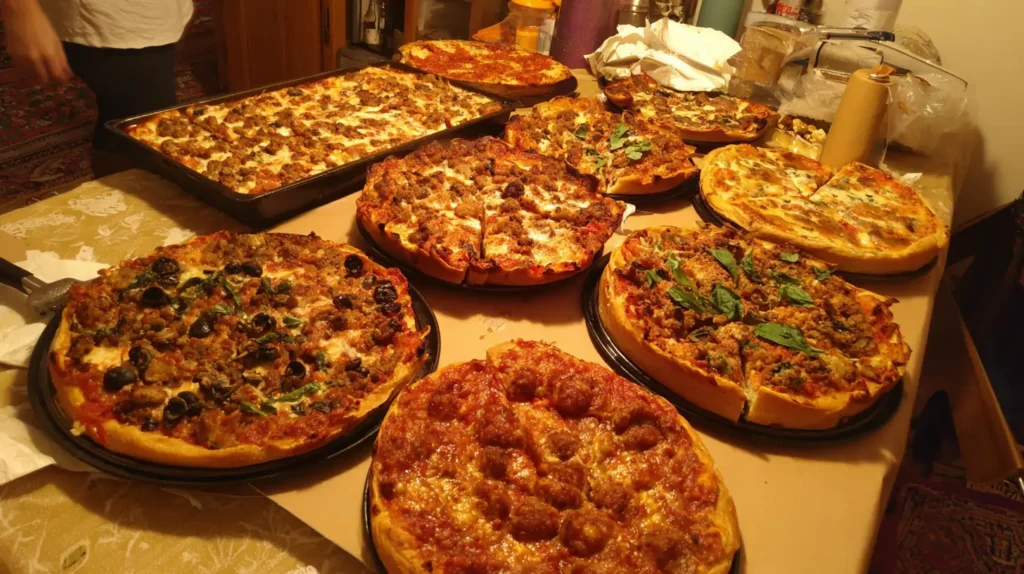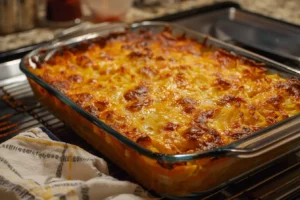Every Sunday evening, a special magic fills the house. The kitchen becomes a stage, flour dusts the air, and laughter bounces off the walls as generations gather to craft something simple yet profound: pizza. It isn’t just about cheese and crust—it’s a ritual, a chance for family to connect, reminisce, and pass down a tradition that’s richer than any secret sauce. For many families around the world, “familial pizza” isn’t just a meal. It’s a celebration of togetherness, shared effort, and the kind of memories that last long after the last slice is gone.
Introduction
Pizza is one of the world’s favorite foods, but its story goes far beyond takeout boxes and cheesy commercials. At the heart of many homes, “familial pizza” is a cherished ritual—a culinary event that brings generations together around the kitchen table. It’s an experience that spans continents and cultures, evolving with each new family that puts its own spin on the tradition.
But what exactly is “familial pizza”? It’s more than just a large pie meant for sharing. Familial pizza is the spirit of collaboration—kneading dough side by side, letting little hands sprinkle cheese, and debating which toppings will make the final cut. It’s about laughter echoing through the kitchen, stories traded as the crust rises, and the anticipation that builds as the oven timer counts down. This kind of pizza isn’t simply food; it’s a vessel for connection, joy, and the creation of new memories.
Throughout this comprehensive guide, we’ll explore every aspect of familial pizza: from its cultural roots and historical traditions, to hands-on recipes and modern twists that accommodate every dietary need. We’ll dive deep into why pizza, of all foods, has become a centerpiece for family gatherings—and how you can make your own pizza nights something everyone looks forward to.
Whether you’re hoping to revive an old tradition, start a new ritual with your kids, or just learn how to make the best family pizza on the block, you’ll find practical tips, heartwarming stories, and expert advice right here. We’ll also share how pizza night can unite families and communities, offer party-planning strategies, and provide solutions for common kitchen mishaps.
Ready to discover the magic of familial pizza? Let’s get started with the origins of this beloved tradition, and learn why a simple slice can mean so much.
Table of Contents
Table of Contents
The Origins of Familial Pizza
Pizza’s journey from humble flatbread to global phenomenon is steeped in history, but its true magic unfolds in the home—where family, flour, and tradition blend together. The concept of “familial pizza” goes back much further than the modern pizza shops we know today. Its roots are deeply woven into cultures where food has always meant connection.
Early Beginnings: The Family Table
The earliest forms of pizza can be traced to ancient civilizations like Egypt, Greece, and Rome, where flatbreads topped with herbs and oils were baked in communal ovens. But it was in Naples, Italy, in the 18th and 19th centuries, that the pizza we recognize today began to take shape—crafted in homes, enjoyed by families, and made with simple, affordable ingredients. Pizza was a meal for everyone, regardless of social status, and baking it became a family event: mothers passed dough recipes to daughters, and children learned to help in the kitchen from an early age.
Tradition Meets Togetherness
Throughout the centuries, making pizza at home became a cherished family tradition. It wasn’t just about feeding a crowd—it was about bonding, storytelling, and passing down techniques. In many Italian families, Sunday afternoons are reserved for pizza-making, with everyone pitching in to roll dough, spread sauce, and share stories as the kitchen fills with warmth and anticipation.
The Evolution of Familial Pizza
As Italian immigrants brought their traditions to the Americas and beyond, the notion of family pizza night took root in new cultures. Neighborhoods would gather for communal meals, and soon, homemade pizza became synonymous with celebration—birthdays, reunions, and holidays.
In America, serving oversized pizzas meant for sharing became increasingly popular throughout the mid-1900s, turning large pies into a staple at family tables and gatherings. Pizzerias started offering oversized pies meant for sharing, mimicking the communal style of eating found in Italian homes. These pizzas, often cut into generous squares or slices, became centerpieces for parties, school events, and family gatherings.
Familial Pizza Around the World
The familial approach to pizza isn’t limited to Italy or America. In the Middle East, families gather to make manakish—flatbreads topped with cheese, za’atar, or meats. In Argentina, fugazzeta (onion-stuffed pizza) brings families together for weekend feasts. Everywhere you look, there’s a version of pizza that reflects the spirit of family, togetherness, and home.
Key Takeaway
From its origins in the communal ovens of Naples to its global status as a family favorite, pizza’s evolution is a testament to the power of food to unite. The tradition of familial pizza continues to adapt, connecting generations through shared recipes, laughter, and love.
What Makes a Pizza “Familial”?
What sets a “familial pizza” apart from just any pizza? It’s not a single recipe or specific topping—it’s a combination of qualities, traditions, and, most importantly, the spirit of sharing. Let’s break down what truly makes a pizza “familial.”
Defining the Familial Pizza
A familial pizza is more than just a big pizza; it’s a meal designed for connection. It usually means a large, shareable pizza—round or rectangular—cut into multiple slices or squares so that everyone at the table gets a piece (or three). But it’s not just about size; it’s about approach and intention.
Key characteristics of familial pizza include:
- Size and Shape: Often oversized, baked to feed a group—whether in a classic round, a rectangular sheet pan, or even multiple smaller pies shared between several people.
- Toppings Variety: Familial pizzas often have sections with different toppings to suit everyone’s tastes, or offer a “pizza bar” where each person adds their own favorite ingredients.
- Communal Preparation: The process is a group effort. Making the dough, prepping toppings, and assembling the pizza is a family affair, not just a one-person job.
- Sharing and Serving: Familial pizza is served right at the table, with slices or pieces passed around, encouraging conversation and laughter.
The Role of Communal Eating
Pizza, by nature, is a food that invites sharing. This tradition stretches back to the earliest days of communal bread ovens, where families would gather to bake together. Eating familial pizza isn’t just about filling up—it’s about togetherness:
- Everyone Eats Together: Unlike some meals where people eat in shifts, pizza brings everyone to the table at once.
- No Formality Needed: Pizza’s casual nature breaks down barriers. You can eat with your hands, swap slices, and enjoy the meal in a relaxed setting.
- Inclusivity: The act of creating and sharing a pizza allows even the youngest or pickiest eaters to feel involved, as everyone gets a say in what goes on their piece.
Cultural Variations: Family Pizza Around the World
While the Italian-American model of a big pie is perhaps the most famous, familial pizza takes many forms:
- Italy: Pizza al taglio (pizza by the slice) is baked in giant rectangular trays, cut into squares, and served at parties and family gatherings.
- United States: The concept of “pizza night” or “family-sized pizza” is a staple, often involving homemade dough and a buffet of toppings for kids to build their own slices.
- Middle East: Manakish and lahmacun—flatbreads topped with cheese, herbs, or meat—are shared at the table, echoing the same spirit.
- Latin America: Pizzas are often adapted to local tastes and made for big gatherings.
Familial Pizza vs. Other Types of Pizza
What’s the difference between a familial pizza and, say, a personal pizza or a commercial pie?
- Personal pizza: Small, made for one, often with a single set of toppings—great for individual cravings, but lacking the social aspect.
- Commercial takeout pizza: Designed for convenience and speed, but often misses the hands-on, communal preparation that makes familial pizza special.
- Familial pizza centers on sharing, celebrating diversity in toppings, and enjoying the experience of eating together as a group. The experience matters as much as the food itself.
The Heart of the Matter
At its core, a familial pizza is a reflection of family itself—diverse, collaborative, and always better when shared. Whether it’s a Sunday ritual, a birthday, or just a spontaneous dinner, it’s a meal that transforms an ordinary evening into a memorable event.
Print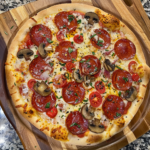
Familial Pizza
- Total Time: 2 hours (including rising)
- Yield: 1 large sheet pan pizza (serves 6–8) 1x
- Diet: Vegetarian
Description
A delicious, crowd-pleasing pizza designed for sharing with family and friends. This easy homemade familial pizza recipe is perfect for family dinners, pizza nights, and special occasions. Customize the toppings to suit everyone’s tastes!
Ingredients
For the Dough:
-
4 cups all-purpose flour
-
1 ½ cups warm water
-
2 tsp active dry yeast
-
2 tbsp olive oil
-
1 ½ tsp salt
-
1 tsp sugar
For the Sauce:
-
1 can (14 oz) crushed tomatoes
-
2 cloves garlic, minced
-
2 tbsp olive oil
-
1 tsp dried oregano
-
Salt and pepper, to taste
Toppings (choose your favorites):
-
2–3 cups shredded mozzarella cheese
-
Sliced pepperoni, sausage, or ham
-
Mushrooms, bell peppers, onions, olives
-
Fresh basil or spinach
-
Additional cheeses (parmesan, burrata, etc.)
Instructions
- Prepare Dough:
In a large bowl, dissolve yeast and sugar in warm water. Let stand until foamy, about 5–10 minutes. Add flour, salt, and olive oil. Mix and knead on a floured surface until smooth and elastic (8–10 minutes). Place in an oiled bowl, cover, and let rise until doubled (1–2 hours). -
Make Sauce:
Sauté garlic in olive oil until fragrant. Add crushed tomatoes, oregano, salt, and pepper. Simmer 10–15 minutes. Let cool. -
Shape Dough:
Preheat oven to 475°F (245°C). Oil a large baking sheet. Punch down dough and stretch to fit the pan. -
Assemble Pizza:
Spread sauce over dough. Sprinkle with cheese and your choice of toppings. Let family members add their favorites. -
Bake:
Place pizza on lowest oven rack. Bake 12–18 minutes until cheese bubbles and crust is golden. For extra crispiness, broil for 1–2 minutes, watching closely. -
Serve:
Let pizza rest a few minutes, then slice and enjoy together!
Notes
- For extra flavor, let dough rise slowly in the fridge for up to 24 hours.
- Divide the pizza into sections to cater to different topping preferences.
-
Leftovers can be stored in an airtight container for up to 3 days.
- Prep Time: 25 minutes
- Cook Time: 15 minutes
- Category: Main Dish
- Method: Baking
- Cuisine: Italian-American
Nutrition
- Serving Size: 1 slice (1/8 pizza)
- Calories: 285
- Sugar: 2g
- Sodium: 510mg
- Fat: 9g
- Saturated Fat: 3.5g
- Unsaturated Fat: 4.5g
- Trans Fat: 0g
- Carbohydrates: 38g
- Fiber: 2g
- Protein: 11g
- Cholesterol: 15mg
Types of Familial Pizza
When it comes to familial pizza, there’s no one-size-fits-all recipe. Across countries, cultures, and even individual households, families have developed their own unique takes—each reflecting personal preferences, local ingredients, and a sense of occasion. Let’s explore the main types of familial pizza and how you can find (or create) the style that fits your family best.
Classic Family-Style Pizzas
Neapolitan & Italian Family Pizzas
The Italian tradition is at the root of family-style pizza. Classic Neapolitan pizzas are usually round, with a thin, chewy crust, baked quickly in a wood-fired oven. While individual pizzas are common in Italian pizzerias, families often make larger versions at home, served uncut at the table for communal slicing and sharing.
Variation: Pizza al taglio (“pizza by the cut”) is a Roman classic, baked in large rectangular trays and cut into squares—a natural fit for groups.
Sicilian Pizza (Sfincione)
Sicilian pizza is legendary for its thick, fluffy crust and rectangular shape. It’s baked in sheet pans, making it perfect for big families or gatherings. Layers of dough, cheese, tomato sauce, and toppings are assembled for a hearty, satisfying meal that can feed a crowd.
American Family Pizza
The U.S. has created its own unique version of the family pizza tradition:
- New York-style: Large, thin-crust pies, usually cut into 8–12 slices, designed for sharing.
- Chicago deep-dish: Thick, indulgent, and filling, often shared among groups.
- Party (Sheet Pan) Pizza: Inspired by school cafeterias and neighborhood parties, this pizza is baked in a large baking tray, cut into squares, and easy to serve at events.
Sheet Pan & “Party” Pizzas
Sheet pan or party pizza is one of the easiest and most approachable ways to enjoy familial pizza with a crowd. The dough is stretched to fit a rectangular baking pan, then loaded with sauce, cheese, and toppings.
- Benefits: Great for feeding a crowd, easy for kids to help assemble, and perfect for customizing different sections with varied toppings.
- Tip: Pre-cut portions for different family members’ favorite flavors.
Regional and Cultural Variations
Every country puts its own stamp on the concept of family pizza:
- Middle East: Manakish (Lebanon/Syria) or Turkish pide—flatbreads topped with cheese, za’atar, or spiced meats, sliced and shared at the table.
- Argentina: Fugazzeta, a double-crusted, onion-and-cheese-stuffed pizza, often enjoyed at large gatherings.
- France: Tarte flambée or “flammekueche”—thin, crispy, topped with cream, onions, and lardons, shared in Alsatian homes.
- India: “Paneer pizza” with local spices, often cooked on a tawa (griddle) and cut for sharing.
Homemade vs. Restaurant Familial Pizzas
Homemade Family Pizza
- Pros: Total control over ingredients, the joy of cooking together, easy to accommodate dietary needs, and lots of room for creativity.
- Cons: Requires time and a bit of planning, but the bonding and fun more than make up for it!
Restaurant Family-Size Pizza
- Many pizzerias offer oversized pies or “family specials” for dine-in or delivery. These are convenient, but they lack the communal kitchen experience and hands-on memories that homemade pizzas create.
Specialty Pizzas for Families
- Stuffed Crust & Cheese Crust Pizzas: Loved by kids and adults alike, stuffed crusts add a playful element to pizza night.
- Half-and-Half or Sectioned Pizzas: Divide the pizza into zones, each with different toppings to please everyone (great for picky eaters or dietary restrictions).
- Breakfast Family Pizza: Topped with eggs, bacon, and veggies for a special weekend brunch.
- Dessert Pizza: Sweet dough topped with chocolate, fruit, or marshmallows for a family treat.
Crowd-Pleaser Pizzas: Inspiration
- Vegetarian Delight: Tomato, mozzarella, mushrooms, peppers, onions—colorful and healthy for the whole family.
- Meat Lovers’ Feast: Sausage, pepperoni, ham, bacon—classic and hearty.
- DIY Pizza Night: Set out bowls of toppings and let each family member decorate their section.
Why Variety Matters
Offering a variety of types and toppings turns pizza night into an event, sparks conversation, and ensures that everyone feels included. It’s not just about eating—it’s about the experience and the memories made along the way.
The Importance of Pizza in Family Traditions
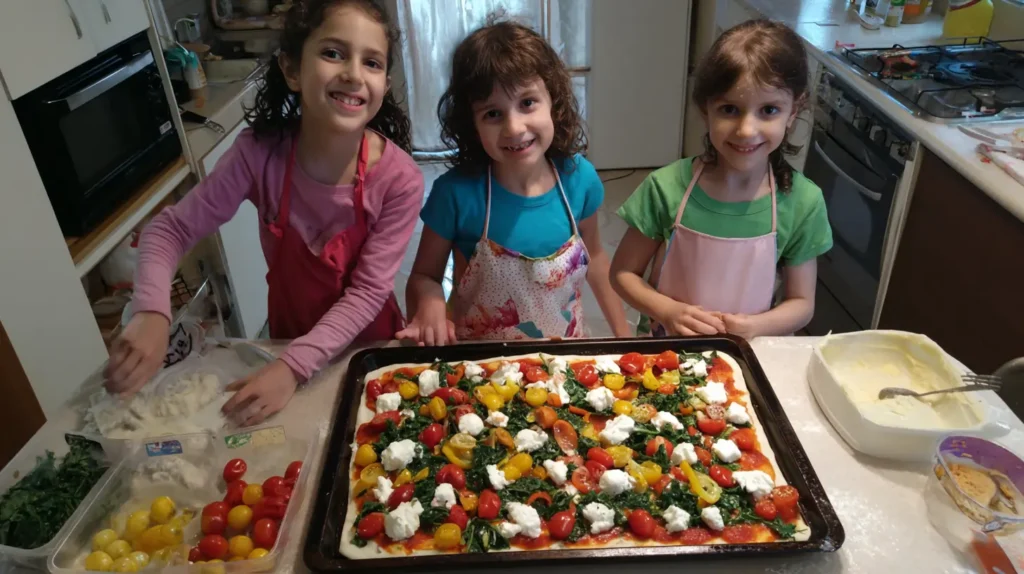
Pizza isn’t just a dish—it’s a ritual woven into the fabric of countless families worldwide. The tradition of gathering for pizza night, whether every week or on special occasions, has become a meaningful anchor in busy modern lives. But what makes pizza such a powerful force in family traditions?
Pizza as a Bonding Experience
Few meals are as participatory as pizza. From kneading dough to sprinkling toppings, every member of the family can contribute, regardless of age or skill level. This hands-on involvement encourages collaboration, patience, and creativity, while offering the perfect setting for conversation and laughter.
- Building Skills & Confidence: Kids develop confidence by shaping dough, learning kitchen safety, and getting creative with toppings.
- Shared Responsibility: The process of making pizza turns mealtime into a team effort, breaking down roles and building unity.
Marking Special Occasions
Pizza has a special way of turning an ordinary day into a festive occasion. Families often reserve pizza night for:
- Birthdays and Anniversaries: Homemade or favorite pizzeria pizzas can become a birthday tradition, paired with games and music.
- When it comes to reunions and holidays, big pizzas are perfect for serving a crowd, often becoming the highlight of family events, festive celebrations, or game day get-togethers.
- Weekly Rituals: Many families designate a specific day—often Friday or Sunday—as “pizza night,” creating something everyone can look forward to.
Stories, Laughter, and Memories
Family pizza nights are the backdrop for countless stories: the time the dough fell on the floor, the sibling squabbles over the last slice, or the joy of discovering a new favorite topping. These stories become cherished family lore, repeated year after year.
- Passing Down Traditions: Recipes, techniques, and even kitchen mishaps are handed down, creating a sense of continuity and belonging.
- Encouraging Openness: The informal, communal nature of pizza night makes it easier for family members to share what’s on their minds, strengthening emotional connections.
Cultural and Generational Bridges
Pizza’s universal appeal makes it a great bridge between generations and cultures. Grandparents might introduce traditional Italian or regional recipes, while kids suggest new, trendy toppings or fusion ideas. The meal becomes a living blend of heritage and innovation.
- Inclusion for All: Pizza’s adaptability ensures that everyone—regardless of dietary restrictions or preferences—can take part, making it the ultimate inclusive meal.
Pizza as Comfort and Celebration
For many, pizza is the ultimate comfort food. After a long week or a tough day, gathering around a hot, freshly baked pizza brings a sense of comfort and togetherness that’s hard to match. At the same time, the same pizza can transform into a feast for celebration, adaptable to any mood or moment.
The Anatomy of the Perfect Familial Pizza
What makes a familial pizza truly unforgettable? It’s a blend of well-chosen ingredients, simple but effective techniques, and the ability to please a crowd. Let’s break down the anatomy of a perfect family pizza, so you can master both the art and the science—while keeping it fun for everyone involved.
The Foundation: Dough
The dough is the heart of any pizza, and for families, the best dough is one that’s forgiving and easy to work with.
- Classic Dough: Start with flour, water, yeast, salt, and a touch of olive oil. For family pizza, choose recipes that don’t require long fermentation times—though, if you plan ahead, an overnight rise brings extra flavor and chewiness.
- Sheet Pan or Thick Crust: Opt for recipes that yield a slightly thicker crust—these are easier for small hands to stretch and less prone to tearing.
- Tips: Let everyone help knead and shape the dough; imperfections add character and make each pizza unique.
The Sauce: Classic and Creative
Every family has their own idea of what makes the best sauce, so feel free to get creative and try different options.
- Classic Red Sauce: Simmer crushed tomatoes with garlic, olive oil, salt, and herbs. Make it ahead and let it cool—this also gives kids a chance to taste and tweak the seasoning.
- White Sauce: Use a mix of ricotta, cream, or béchamel for a creamy twist.
- Pesto or Oil-Based: Basil pesto, garlic oil, or even barbecue sauce can change up the flavor profile.
- Tip: Divide the pizza in half and try two different sauces to satisfy all tastes.
The Cheese: Stretch, Melt, and Flavor
Cheese is often the star of family pizza—gooey, golden, and irresistible.
- Mozzarella: The classic choice, either whole milk or part-skim. For a more traditional Neapolitan touch, use fresh mozzarella torn into pieces.
- Blend It: Add provolone, cheddar, parmesan, or fontina for flavor complexity.
- Dairy-Free Options: Use vegan cheeses or sprinkle nutritional yeast for families with dietary needs.
- Tip: Let kids sprinkle the cheese—it’s the most fun job and always ends in giggles.
Toppings: Pleasing the Crowd
This is where the pizza becomes truly “familial.” Variety and customization are key.
- Meats: Pepperoni, sausage, ham, or even barbecue chicken.
- Veggies: Bell peppers, onions, mushrooms, olives, spinach, and more.
- Divided Pizza: Create topping “zones” for picky eaters or dietary needs. Draw an invisible line with a pepper slice to mark where one topping ends and another begins!
- Get Creative: Try pineapple, artichokes, or even sliced potatoes.
Slicing, Serving, and Sharing
- Slice Shapes: Traditional wedges, easy-to-share squares (great for sheet pan pizza), or fun “mini pizzas” made from dividing the dough.
- Serving Tips: Serve pizza straight from the pan on a cutting board in the center of the table, encouraging everyone to grab their favorite slice.
- Side Dishes: Consider serving with salads, veggie sticks, or simple appetizers to round out the meal.
The Family Touch
The perfect familial pizza isn’t about perfection. It’s about the experience—little handprints in the dough, extra cheese “just because,” and the joy of eating something made together. Let every pizza reflect your family’s personality, quirks, and favorite flavors.
Step-by-Step Guide: Making Familial Pizza at Home
Creating a memorable family pizza night doesn’t require a fancy oven or expert skills—just a willingness to get hands-on, a few quality ingredients, and a sense of fun. Here’s a detailed, step-by-step guide for making familial pizza that everyone can be proud of, from dough to table.
Step 1: Gather Your Ingredients
For the Dough:
- 4 cups all-purpose or bread flour
- 1 ½ cups warm water
- 2 tsp active dry yeast
- 2 tbsp olive oil
- 1 ½ tsp salt
- 1 tsp sugar
For the Sauce:
- 1 can (14 oz) crushed tomatoes
- 2–3 cloves garlic, minced
- 2 tbsp olive oil
- 1 tsp dried oregano
- Salt and pepper to taste
Toppings (choose a mix):
- Shredded mozzarella and other cheeses
- Sliced pepperoni, sausage, ham, cooked chicken
- Mushrooms, onions, bell peppers, olives, spinach, tomatoes
- Fresh basil, pineapple, artichokes, or any family favorites
Step 2: Prepare the Dough
- Activate Yeast: In a large bowl, mix warm water, sugar, and yeast. Let sit for 5–10 minutes until foamy.
- Mix Dough: Add flour, salt, and olive oil. Stir until a shaggy dough forms.
- Knead: Transfer the dough to a lightly floured surface and work it by hand for 8 to 10 minutes until it becomes soft and elastic. (Kids love to help with this step!)
- First Rise: Place dough in an oiled bowl, cover with a towel, and let rise in a warm spot for 1–2 hours, or until doubled in size.
Tip: To enhance both flavor and texture, prepare the dough in the morning and allow it to rise slowly in the refrigerator throughout the day.
Step 3: Make the Sauce
- In a saucepan, heat olive oil and sauté garlic until fragrant (1–2 minutes).
- Add crushed tomatoes, oregano, salt, and pepper.
- Simmer for 10–15 minutes, stirring occasionally. Taste and adjust seasoning.
Option: Make sauce ahead of time and store in the fridge, or let kids help stir and taste.
Step 4: Prep the Toppings
- Slice, chop, or grate all toppings in advance and arrange them in bowls.
- Set up a “topping station” on the counter or table so everyone can access their favorites.
- Involve kids in washing veggies, grating cheese, or laying out ingredients.
Step 5: Shape the Dough
- Preheat your oven to the highest temperature it allows (475–500°F/250°C or higher).
- Brush a generous layer of oil onto a large pizza pan or baking sheet.
- Punch down the risen dough and turn it out onto a floured surface.
- For sheet pan pizza: Stretch and press the dough to fit the pan. For round pizzas: Divide dough in half or thirds and shape as desired.
Tip: Don’t worry about perfect circles! The fun is in the process.
Step 6: Assemble the Pizza
- Spread a thin layer of sauce over the dough, leaving a border for the crust.
- Sprinkle cheese evenly.
- Invite everyone to personalize their part of the pizza with their favorite toppings, or divide the pie into halves or quarters for different combinations.
- Finish with a drizzle of olive oil or a sprinkle of herbs.
Step 7: Bake to Perfection
- Bake the pizza on the bottom rack of your oven to achieve a crispier crust.
- Bake for 12 to 18 minutes, or until the cheese is bubbling and the crust turns a rich golden brown.
- For an even crispier finish, place the pizza under the broiler for 1 to 2 minutes, keeping a close eye to prevent burning.
Step 8: Serve and Enjoy
- Take the pizza out of the oven and allow it to rest for a few minutes before slicing.
- Slice with a pizza cutter or sharp knife.
- Place the pizza on a big board in the center of the table and invite everyone to grab their slice.
Step 9: Get Creative
- Make “mini pizzas” with extra dough for kids.
- Experiment with creative pizza themes, like taco-inspired, garden vegetable, or breakfast-style pizzas.
- Encourage taste-testing, sharing, and laughter.
Step 10: Make It a Tradition
- Create a special family playlist for pizza night.
- Take turns choosing toppings or inventing new combinations.
- Record your family’s favorite recipes and memories for future generations.
A homemade familial pizza is about more than just food—it’s about building connections, sharing the work, and savoring the results together.
Healthy and Dietary Variations
A wonderful aspect of familial pizza is how adaptable it can be. Whether your family has dietary restrictions, health goals, or just adventurous palates, pizza can be tailored to suit everyone—without sacrificing flavor or fun. Here’s how to make pizza night inclusive, nutritious, and just as delicious.
Gluten-Free Options
Crusts:
- Ready-made gluten-free pizza crusts are widely available in supermarkets, offering a convenient option for quick preparation.
- Homemade alternatives: Try making dough with a blend of gluten-free flours (rice, almond, or chickpea), or use a cauliflower-based crust for a lighter, veggie-rich option.
- Tip: Add a pinch of xanthan gum for elasticity if making your own gluten-free dough.
Dairy-Free and Vegan Pizza
Cheese substitutes:
- Plant-based cheeses (store-bought or homemade cashew cheese) melt and stretch like the real thing.
- Nutritional yeast provides a cheesy taste while remaining completely dairy-free.
- Dairy-free sauces: Tomato, olive oil, and pesto made without cheese work well as bases.
Toppings:
- All vegetables and fruits are naturally vegan and gluten-free. Roasted veggies, caramelized onions, and even fruits like pineapple or figs add big flavor.
- Vegan protein: Try plant-based sausage, marinated tofu, or tempeh crumbles.
Whole-Grain and Alternative Crusts
Boost nutrition by swapping white flour for:
- Whole wheat flour boosts the fiber content and introduces a subtle, nutty taste.
- Spelt, rye, or ancient grains: For a richer, more complex taste.
- Cauliflower or broccoli crusts: Lower in carbs and gluten-free, these crusts sneak extra veggies into every bite.
Lower-Sodium and Heart-Healthy Pizzas
- Sauce: Make your own using no-salt-added tomatoes and lots of herbs.
- Cheese: Use part-skim mozzarella, feta, or skip cheese altogether.
- Toppings: Load up on fresh veggies, lean grilled chicken, or seafood for more nutrients and less sodium.
Allergy-Friendly Tips
- Nut-free: Steer clear of pesto made with nuts and always read labels to ensure products are safe from cross-contamination.
- Egg-free: Most traditional pizza dough recipes are naturally egg-free, but always double-check if buying pre-made.
- Soy-free: Use real cheese or soy-free vegan cheese, and avoid certain meat substitutes.
Make It a Family Adventure
- Have family members vote on which healthy swaps to try each week.
- Motivate kids to try a variety of vegetables or toppings by arranging them in colorful “pizza rainbow” patterns.
- Celebrate little wins—like making a crust from scratch or discovering a new favorite sauce.
Keeping It Fun (and Realistic)
Healthy pizza doesn’t mean boring pizza. By involving everyone in ingredient choices, you teach kids (and adults!) that nutritious food can be just as tasty and satisfying as classic versions. Remember, balance is key—sometimes, the joy of family pizza night is worth a little extra cheese or an extra slice.
The Social Impact of Familial Pizza
Pizza has a unique ability to bring people together—not just within families, but also across neighborhoods, communities, and cultures. Its casual, shareable nature makes it a go-to choice for gatherings that foster friendship, inclusion, and community spirit.
Pizza as a Unifier
Few foods are as universally beloved as pizza. When a fresh pie arrives at the table—whether homemade or delivered—everyone is welcome. The simple act of breaking bread (or sharing a slice) creates an instant sense of camaraderie, breaking down social barriers and encouraging conversation. For families, pizza night isn’t just about eating; it’s about making memories and strengthening bonds that last beyond the meal.
Community Gatherings
Pizza often plays a starring role at larger social events:
- School functions and fundraisers: Sheet pan pizzas can feed a crowd, making them a staple for bake sales, PTA meetings, and class parties.
- Charitable events: Many organizations use pizza as a way to bring people together, raise money, or thank volunteers.
- Religious and cultural celebrations: Pizza (or similar flatbreads) is often adapted for group meals at churches, synagogues, and community centers, reflecting local flavors and traditions.
Teaching Generosity and Inclusion
Pizza’s shareable format naturally teaches children (and adults) the value of generosity. Passing slices, letting others choose toppings, and making sure everyone gets a piece reinforce the principles of kindness, compromise, and empathy. These important lessons extend well beyond the dinner table.
Lasting Impact
Whether it’s a weekly family dinner or a community block party, familial pizza creates a space where everyone feels included. The laughter, teamwork, and sense of belonging fostered around a pizza help build stronger families and more connected communities.
Advanced Family Pizza-Making Tips & Techniques
Elevate your familial pizza nights with a few expert tricks that make your homemade pizza even more memorable.
Scaling up for a crowd is easy when you bake on large sheet pans. This “sheet pan pizza” approach is perfect for big family gatherings, allowing everyone to enjoy plenty of slices and flavors. If you’re looking for fresh ideas, check out our collection of sheet pan pizza recipes to make your next familial pizza night a true feast.
Letting your dough rise overnight in the fridge will give your familial pizza a deeper flavor and chewier texture. For a classic Italian touch, try using bread flour with a little olive oil for an airy, crisp crust. Don’t be afraid to get creative with toppings—divide your familial pizza into sections so each family member can add their favorites. This is a fun way to make your family pizza night truly personalized and inclusive.
If you want a crispy crust like the pros, use a preheated pizza stone or steel. It’s a simple investment that transforms homemade familial pizza into a pizzeria-quality treat.
Entertaining with Familial Pizza: Parties & Events
Hosting a party or family event? Familial pizza is the ultimate crowd-pleaser. You can set up a pizza bar where guests build their own mini pizzas or top different sections of a large pie—making every slice a reflection of your group’s tastes.
For birthday parties, reunions, or game nights, this hands-on approach turns pizza-making into a shared activity and helps break the ice among guests. Don’t forget to provide plenty of topping choices and encourage kids and adults alike to get creative.
Need more inspiration for your next family-friendly gathering? Browse our party food for kids collection for side dishes and desserts that pair perfectly with familial pizza.
Familial pizza parties are all about fun, laughter, and bringing everyone together around a meal everyone loves.
Pizza Pairings for the Whole Family
A great familial pizza night isn’t just about the pizza—it’s also about the sides and drinks that make the meal feel like a true feast. When planning your family pizza dinner, think about balance, color, and flavors everyone will enjoy.
Family-Friendly Drinks:
Pair your pizza with sparkling water and fresh citrus, homemade lemonade, or a fun fruit punch for the kids. For adults, Italian sodas or a crisp glass of wine can complement classic toppings.
Side Dishes:
Simple salads with mixed greens, cherry tomatoes, and a drizzle of olive oil are a perfect fresh counterpoint to cheesy pizza. Roasted vegetables, marinated olives, or a fresh fruit salad make great additions to your spread.
Dessert Ideas:
Cap off your familial pizza night with a sweet treat. Try a fruit-based dessert like baked apples, or browse your favorite dessert ideas for inspiration.
With the right pairings, your pizza night can become a well-rounded, memorable family tradition.
Clean-Up and Leftovers: Making Pizza Last
After a successful familial pizza night, a little teamwork can make cleaning up part of the tradition. Get everyone involved—kids can help clear plates, wipe the table, or store leftovers, making the process faster and lighter.
Quick Clean-Up Tips:
- Line your baking pans with parchment for easy cleanup.
- Set up a “clean-up crew” with small, fun jobs for each family member.
- Place leftover pizza in sealed containers and refrigerate; it will stay fresh for up to three days.
Reheating & Creative Leftovers:
- Reheat slices in a skillet or oven for a crisp crust—avoid microwaving if you want to keep that signature crunch.
- Leftover pizza can be cut into strips for lunchboxes or chopped and tossed into salads for a new twist.
- Got more time? Try transforming leftover dough into fun breakfast recipes or snacks—browse the breakfast section for creative ideas you can pair with pizza leftovers.
Keeping the kitchen tidy and making the most of leftovers is another way to extend the joy of familial pizza beyond a single meal.
Troubleshooting: Common Familial Pizza Problems
Even the most experienced families can run into a few hiccups during pizza night. Don’t worry—every problem has a simple solution!
Soggy Crust:
If your familial pizza crust turns out soggy, try preheating your oven (and pizza stone or pan) longer, and avoid overloading with sauce or wet toppings.
Burnt Edges, Undercooked Center:
This usually means your oven is too hot or the pizza is too thick in the middle. Stretch the dough evenly and adjust oven racks for balanced cooking.
Topping Troubles:
Picky eaters? Divide the pizza into sections for custom toppings.
Cheese won’t melt? Use freshly shredded cheese and sprinkle evenly for the best gooey results.
Dough Sticking:
Dust your surface and hands with flour, and line pans with parchment to keep dough from sticking.
Leftovers Not Crisp:
Reheat leftover pizza in a dry skillet or hot oven, not the microwave, for a crispier slice.
With a few simple adjustments, any familial pizza night can end on a high note—mistakes included!
Top Tools and Gadgets for Family Pizza Night
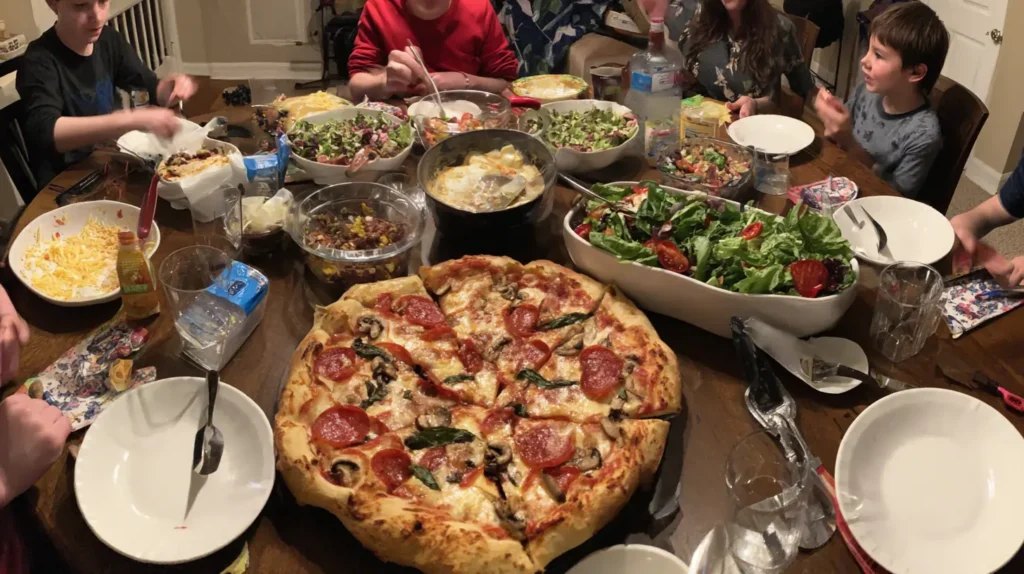
While you don’t need fancy equipment to enjoy familial pizza, a few handy tools can make the process easier and more fun for everyone.
- Pizza Cutter: A sharp pizza wheel or rocker blade makes slicing effortless and safe for family members to use (with supervision).
- Baking Pan or Pizza Stone: A sturdy baking sheet works for any oven, while a pizza stone or steel creates a crispier crust.
- Mixing Bowls & Rolling Pins: Let everyone have their own bowl for mixing dough or rolling out mini pizzas.
- Cheese Grater: Shredding your own cheese adds freshness—and it’s a job kids love!
- Topping Bowls: Small bowls make it easy for everyone to customize their slice, turning topping prep into a shared activity.
For easy breakfast-after-pizza ideas, some families also keep a good nonstick skillet on hand—find inspiration in our breakfast recipes for using leftover dough or toppings.
Having the right tools makes familial pizza night smoother and keeps everyone engaged, from prep to the last slice.
Best Family Pizza Recipes (Highlight Section)
Every family develops its own favorites, but here are some reliable crowd-pleasers that work for all ages and tastes. Rotate these on your familial pizza nights to keep everyone excited:
1. Classic Margherita Pizza
Simple tomato sauce, mozzarella, and fresh basil—always a winner with kids and adults.
2. Pepperoni & Veggie Combo
Half the pizza with classic pepperoni, the other half loaded with mushrooms, bell peppers, and onions for a balanced family meal.
3. Cheesy “Pizza Crunchers”
For a fun twist, try Pizza Crunchers—bite-sized, crunchy snacks that double as appetizers or lunchbox treats.
4. Breakfast Pizza
Use leftover dough to make a morning treat with eggs, cheese, and cooked sausage or veggies. Perfect for weekends!
5. Burrata-Topped White Pizza
Add creamy burrata cheese and garlic oil for a rich, shareable pie that feels extra special.
The key to great familial pizza recipes is flexibility. Let everyone help choose toppings and get hands-on with prep. Every successful recipe is another story for your family to share!
Conclusion
Familial pizza is more than just a meal—it’s a tradition that brings families together, sparks creativity in the kitchen, and leaves everyone with happy memories (and full bellies). Whether you’re making a classic Margherita, a fun twist like Pizza Crunchers, or experimenting with new toppings, the real magic happens when everyone pitches in and shares the results.
Pizza night offers an opportunity to connect, laugh, and teach kids important skills, all while enjoying one of the world’s favorite foods. By embracing the spirit of familial pizza—sharing, collaborating, and celebrating every slice—you create a legacy that goes far beyond the dinner table.
Remember, there’s no single “right” way to do familial pizza. Adapt recipes for dietary needs, invite everyone to get involved, and don’t stress about perfection. The best pizzas are those made with love, laughter, and a dash of family fun.
So when you gather for your next pizza night, enjoy the delicious food and cherish the sense of connection that makes familial pizza so meaningful. Here’s to many more delicious pizza nights and memories with the people you love most!
Whether you’re crafting a classic Margherita or experimenting with new toppings, familial pizza night is all about sharing, laughter, and creativity. If you’re looking for a fun twist to add to your pizza spread, try making Pizza Crunchers—they’re a crowd-pleaser for both kids and adults. For cheese lovers, top your pizza with fresh burrata cheese to create a rich, creamy finish everyone will remember. And if you want to keep family meals simple on busy days, our 3 Ingredient Slow Cooker Recipes offer more ways to bring everyone to the table with ease.
Frequently Asked Questions (FAQs)
What is familial pizza and how is it different from regular pizza?
Familial pizza refers to a pizza made and enjoyed specifically in a family setting, emphasizing togetherness, sharing, and hands-on preparation. Unlike restaurant or takeout pizza, familial pizza often involves everyone in the process—from kneading the dough to choosing toppings—and focuses on serving a crowd in a casual, joyful way.
How do you make familial pizza night fun for kids?
The best way to get kids excited about familial pizza night is to let them help! Assign age-appropriate tasks like sprinkling cheese, choosing toppings, or even stretching the dough. Make it a game by giving everyone a section of the pizza to decorate. These moments create lasting family memories.
What’s the best way to reheat leftover familial pizza?
For a crisp crust, reheat leftover pizza in a preheated oven or dry skillet. Avoid microwaving, which can make the crust soggy. Store leftovers in an airtight container in the fridge for up to three days.
Can you freeze familial pizza dough for future pizza nights?
Yes! After the first rise, divide the dough, wrap tightly, and freeze. Thaw in the fridge overnight and let it come to room temperature before shaping.
for more recipes follow me in Facebook, Pinterest and medium.
